The Cornell Lab Bird Academy › Discussion Groups › Nature Journaling and Field Sketching › Jump Right in!
-

-
Drawing off of this photo was quite difficult for me because I'm such a perfectionist. Noticing where colors were supposed to be came pretty easy to me, I am just not very good with watercolor so it was challenging to make the color look nice on paper. If I weren't asked to draw this photo I don't think I would have noticed the detail on the wing that feeds into the tail. It will definitely take me lots of tries to get better. I think it will be hard for me to draw live things because it moves, and I am a slow artist.
-
 It is great to see so many different sketching levels, that you can start even with no experience and learn from everyone else's drawings. It helps me as much to look at other's drawings as at the photo itself. It's good to start just pencil for shapes and details before worrying about the colors.
It is great to see so many different sketching levels, that you can start even with no experience and learn from everyone else's drawings. It helps me as much to look at other's drawings as at the photo itself. It's good to start just pencil for shapes and details before worrying about the colors. -

-

-
I laughed at “wait until the paint is dry...” I had the same lesson.
-
-
The sketch enabled me to focus on areas of contrast - the lights and darks of the feathering, especially around the face and eye where the shading is subtel. It also "forced" me to concentrate on details, the fine feathering of the warbler's chest, the fine lines in the tail feathers. I can see where sketching (which is new to me) will aid greatly when painting watercolors (also new, though I have had a few watercolor classes). The sketch allows me to define the areas of contrast before I lay down paint. The great advantage of the photograph is that the subject is still! I have never sketched or painted in nature and I anticipate a steep learning curve for me! This was a fun task.

-
"C:\Users\MICKE\OneDrive\Desktop\Journal course\
 DSC_9438.JPG"
DSC_9438.JPG" -
 Drawings capture movement, a feeling, better than photographs do. You look carefully and you emphasise some things while skimming over others. In that sense drawings are more like the eye sees, selectively.
I love photographing birds; photographs capture the moment, allow you to notice detail later, form a basis to identify something again in future,. Best of all they capture behaviour, and how things change over the seasons and over time.
But when you draw you notice so much more. That is why I hope to learn from this. When you draw from a photograph, you have all the time in the world, and you obsess, and sometimes the more you correct the worse it looks. Drawing from real life you have to be decisive, capture the essence, so notice the essence and then translate it into a few lines quickly. I have done a little of it but not much. Things never stay still for long enough and I can never remember the detail of how they look once they have moved. So often I end up doing composites of different birds, say. Not great, but I make do.
I struggled with the proportions - head way too big for the body, so the body had to grow. I just could not get the shape of the top of the head right - it is rounded yet flat, and this is the best I could manage, but it does not quite capture it. I find the feathers with a pale edge so difficult to do, and their angle and the way they overlap. and somehow, I kept drawing the legs for a bird that was slightly turned towards me, but the body in profile. I could not get it right!
I did not dare colour this. So many times I draw something just about respectable, and then add colour and it looks like a five year old drew it. I hope to learn to colour things so they enhance the picture
Drawings capture movement, a feeling, better than photographs do. You look carefully and you emphasise some things while skimming over others. In that sense drawings are more like the eye sees, selectively.
I love photographing birds; photographs capture the moment, allow you to notice detail later, form a basis to identify something again in future,. Best of all they capture behaviour, and how things change over the seasons and over time.
But when you draw you notice so much more. That is why I hope to learn from this. When you draw from a photograph, you have all the time in the world, and you obsess, and sometimes the more you correct the worse it looks. Drawing from real life you have to be decisive, capture the essence, so notice the essence and then translate it into a few lines quickly. I have done a little of it but not much. Things never stay still for long enough and I can never remember the detail of how they look once they have moved. So often I end up doing composites of different birds, say. Not great, but I make do.
I struggled with the proportions - head way too big for the body, so the body had to grow. I just could not get the shape of the top of the head right - it is rounded yet flat, and this is the best I could manage, but it does not quite capture it. I find the feathers with a pale edge so difficult to do, and their angle and the way they overlap. and somehow, I kept drawing the legs for a bird that was slightly turned towards me, but the body in profile. I could not get it right!
I did not dare colour this. So many times I draw something just about respectable, and then add colour and it looks like a five year old drew it. I hope to learn to colour things so they enhance the picture -
I made this sketch of a plant and was wondering if anyone out there could please tell me if they know what it could be - I hope you can tell from the drawing! I found it in a park in Brussels, but a lot of the local weeds are the same as the ones in the US.

-
I use an app called Seek to know what plant I'm looking at. Love it!
-
@Los Thanks! - I'll give it a try.
-
something in the Aster family.
-
@Allie Thanks!
-
Another app/website suggestion is iNaturalist - its ability to ID from photos is amazing!
-
-

-
The bird was not too difficult - the hard part for me was depicting the lichen, moss and texture on the branch. I think drawing from a photo is easier as it can be enlarged to show detail. But there is nothing quite like being outside in Nature with sketchbook in hand despite the challenges of weather and insects.

-

 I was very excited to try the new watercolors and watercolor brush suggested in this course. So first I did a color drawing then the pencil drawing. I overworked each drawing.I struggle to get the right angles and proportions. When drawing from a photo I have so much time to think and I don't concentrate on the essence and gesture in the moment but details. My drawing ability , lack of knowledge of bird anatomy and desire to make a realistic drawing stop me from looking at the overall shape and angle of the bird. I'm like a kid in the candy shop caught by all the colored candy (details) not knowing which to choose. I still had fun trying!
I was very excited to try the new watercolors and watercolor brush suggested in this course. So first I did a color drawing then the pencil drawing. I overworked each drawing.I struggle to get the right angles and proportions. When drawing from a photo I have so much time to think and I don't concentrate on the essence and gesture in the moment but details. My drawing ability , lack of knowledge of bird anatomy and desire to make a realistic drawing stop me from looking at the overall shape and angle of the bird. I'm like a kid in the candy shop caught by all the colored candy (details) not knowing which to choose. I still had fun trying! -
 Drawing from a photo I found I could get bogged down in detail so I tried to sketch quickly and take notes of what I noticed. If I had not drawn the picture I may not have noticed the different textures of feathers, the bright yellow undersides of the feet, and the bug nibbled leaf.
Drawing from a photo I found I could get bogged down in detail so I tried to sketch quickly and take notes of what I noticed. If I had not drawn the picture I may not have noticed the different textures of feathers, the bright yellow undersides of the feet, and the bug nibbled leaf. -
 After years of doing technical drawings using a computer, it was nice to use a pencil and paper to draw. (Although I need practice) The longer I took the more details I seemed to have missed.
After years of doing technical drawings using a computer, it was nice to use a pencil and paper to draw. (Although I need practice) The longer I took the more details I seemed to have missed. -
This was challenging for me. I found it hard to get the scale and proportions correct. And the feet. Bird feet are hard for me. Drawing from a picture is easier in the sense that the subject holds still, though. I think that one thing I really want to work on is capturing the essence - the important shapes, etc., quickly in the field. So often the subjects do not hold still, so quick sketching is a valuable tool. I think I would not have noticed the amount of black and gray streaking on the wings. If I wasn't drawing it I would have just described it as yellow with a little reddish brown. Nature journaling really makes you pay attention to the details.

-
The shape of the bird came easily; however the details were challenging - the angle of the head, the soft feathers, and the color variations. I found the water colors challenging - to get the colors to come together to create the whole bird and capture the softness of the feathers and the gradations of the coloring. I noticed the softness of the feathers and the reddish brown on the chest that I may not have noticed without drawing the bird. This would definitely make a difference in nature journaling if I can allow these details to come through in my drawing and paintings.
-
I wish I knew how to draw feathers accurately. Would like to see a close up of the anatomy of a feather. I noticed the many gradations of color from yellow to grey to black. The drawing cries out for color.

-
Hello Patricia and all you Nature Journalers: Bird Academy actually has a free web learning page called All About Feathers. All About Feathers Website Click on the above website if you want to learn and about and visualize feathers and their anatomy. Enjoy.
-
@Lee Ann van Leer Thank you!
-
@Lee Ann van Leer Thank you Lee Ann!!
-
@Lee Ann van Leer Thank you! That’s helpful.
-
@Lee Ann van Leer Fascinating study on feathers. This was very informative. Thank you for sharing this link.
-
-

-
 From photo, I could see different textures of feathers, and also get general geometric shape of subject fairly quickly. This is a technique issue, but it was hard to get fine details of shading rendered with watercolors. I'd use colored pencils in the future. Photo allowed me to get shape of eyes, legs, and beak fairly accurately, which might be difficult from live observation.
From photo, I could see different textures of feathers, and also get general geometric shape of subject fairly quickly. This is a technique issue, but it was hard to get fine details of shading rendered with watercolors. I'd use colored pencils in the future. Photo allowed me to get shape of eyes, legs, and beak fairly accurately, which might be difficult from live observation. -
Drawing from a photo made me feel a little more secure as the bird was not moving. I did not feel stressed for time. What I noticed by drawing from the photo were the black stripes on the wings and tail and the red striations on the front of the bird, also the talons on the branch.

-
 1. The image was stationary in the photo and therefore I could take my time and observe the whole scene properly. I could only describe the colour in the drawing which was captured realistically in the photo.
2. I would not have noticed the lichen and moss on the branches and the reddish/brown streaks on the bird's chest. The extra bird detail could help with the final identification.
1. The image was stationary in the photo and therefore I could take my time and observe the whole scene properly. I could only describe the colour in the drawing which was captured realistically in the photo.
2. I would not have noticed the lichen and moss on the branches and the reddish/brown streaks on the bird's chest. The extra bird detail could help with the final identification. -
Drawing from the photo made it easier to concentrate on the details and colors. As for a challenge, I think seeing the bird live would help with the way the light interacts with the feathers. The photo offered detail on the texture of the feathers that I might not have noticed. The bird appeared "fluffier" than I might notice live. Yes, this could have an impact on nature journaling especially on live animals that are being drawn.
-
Advantages to photos would be quickly capturing multiple movements and actions of an animal. The advantages to drawing is the subtle movement and depth of those movements.

-
 Drawing from the photo was easy-peasy - that little guy isn't going anywhere, so I can take my time! Challenging? How to know where to stop adding detail? I could sit all day and detail the primary and secondary wing feathers, the shading of his/her neck and delicate legs and nails...
Might not have noticed the shape of the warbler's beak, sort of an "underbite", where the lower part of the beak is larger than the upper part... wouldn't have noticed how the little claws worked as they clamped around the twig... and how the feathers are tight around the head and softer and "fluffier" near the back and vent..
There's drawing from seeing and drawing from "knowing", and the first is probably going to give me the lifelike, dynamic, captured-in-motion look that I'm after, even if I think I'm seeing it wrong... the restatements help make it look like stop-action photography...
Drawing from the photo was easy-peasy - that little guy isn't going anywhere, so I can take my time! Challenging? How to know where to stop adding detail? I could sit all day and detail the primary and secondary wing feathers, the shading of his/her neck and delicate legs and nails...
Might not have noticed the shape of the warbler's beak, sort of an "underbite", where the lower part of the beak is larger than the upper part... wouldn't have noticed how the little claws worked as they clamped around the twig... and how the feathers are tight around the head and softer and "fluffier" near the back and vent..
There's drawing from seeing and drawing from "knowing", and the first is probably going to give me the lifelike, dynamic, captured-in-motion look that I'm after, even if I think I'm seeing it wrong... the restatements help make it look like stop-action photography...
-
That is such a good drawing - it is alive. It is so easy to draw something stiff from a photograph, maybe because of all the time one has to look and look again; stiff this is not.
-
-

Read More:
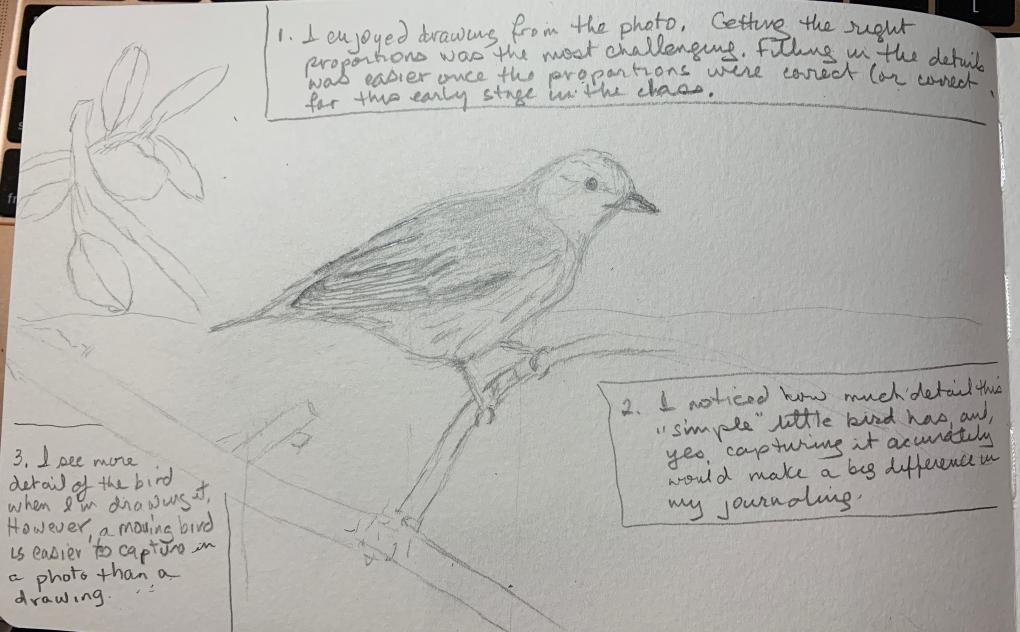
 It is great to see so many different sketching levels, that you can start even with no experience and learn from everyone else's drawings. It helps me as much to look at other's drawings as at the photo itself. It's good to start just pencil for shapes and details before worrying about the colors.
It is great to see so many different sketching levels, that you can start even with no experience and learn from everyone else's drawings. It helps me as much to look at other's drawings as at the photo itself. It's good to start just pencil for shapes and details before worrying about the colors. 
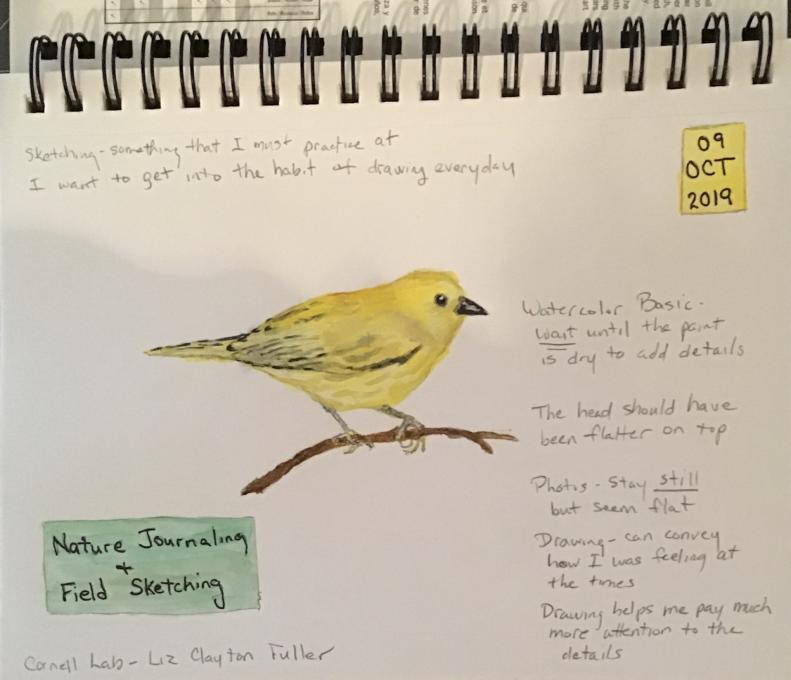
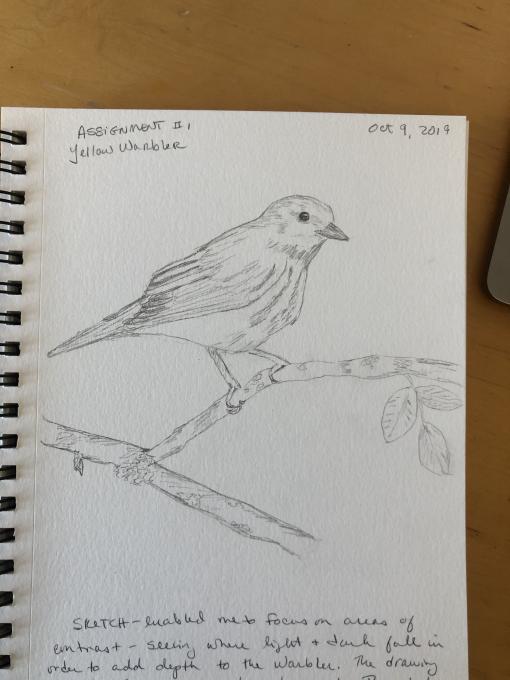
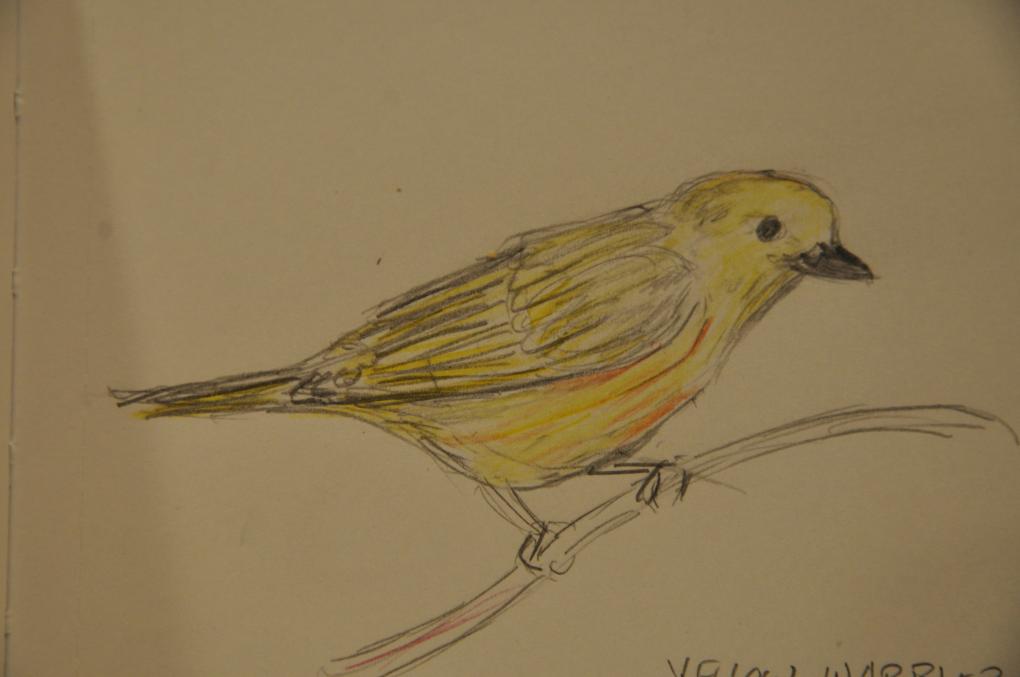 DSC_9438.JPG"
DSC_9438.JPG"  Drawings capture movement, a feeling, better than photographs do. You look carefully and you emphasise some things while skimming over others. In that sense drawings are more like the eye sees, selectively.
I love photographing birds; photographs capture the moment, allow you to notice detail later, form a basis to identify something again in future,. Best of all they capture behaviour, and how things change over the seasons and over time.
But when you draw you notice so much more. That is why I hope to learn from this. When you draw from a photograph, you have all the time in the world, and you obsess, and sometimes the more you correct the worse it looks. Drawing from real life you have to be decisive, capture the essence, so notice the essence and then translate it into a few lines quickly. I have done a little of it but not much. Things never stay still for long enough and I can never remember the detail of how they look once they have moved. So often I end up doing composites of different birds, say. Not great, but I make do.
I struggled with the proportions - head way too big for the body, so the body had to grow. I just could not get the shape of the top of the head right - it is rounded yet flat, and this is the best I could manage, but it does not quite capture it. I find the feathers with a pale edge so difficult to do, and their angle and the way they overlap. and somehow, I kept drawing the legs for a bird that was slightly turned towards me, but the body in profile. I could not get it right!
I did not dare colour this. So many times I draw something just about respectable, and then add colour and it looks like a five year old drew it. I hope to learn to colour things so they enhance the picture
Drawings capture movement, a feeling, better than photographs do. You look carefully and you emphasise some things while skimming over others. In that sense drawings are more like the eye sees, selectively.
I love photographing birds; photographs capture the moment, allow you to notice detail later, form a basis to identify something again in future,. Best of all they capture behaviour, and how things change over the seasons and over time.
But when you draw you notice so much more. That is why I hope to learn from this. When you draw from a photograph, you have all the time in the world, and you obsess, and sometimes the more you correct the worse it looks. Drawing from real life you have to be decisive, capture the essence, so notice the essence and then translate it into a few lines quickly. I have done a little of it but not much. Things never stay still for long enough and I can never remember the detail of how they look once they have moved. So often I end up doing composites of different birds, say. Not great, but I make do.
I struggled with the proportions - head way too big for the body, so the body had to grow. I just could not get the shape of the top of the head right - it is rounded yet flat, and this is the best I could manage, but it does not quite capture it. I find the feathers with a pale edge so difficult to do, and their angle and the way they overlap. and somehow, I kept drawing the legs for a bird that was slightly turned towards me, but the body in profile. I could not get it right!
I did not dare colour this. So many times I draw something just about respectable, and then add colour and it looks like a five year old drew it. I hope to learn to colour things so they enhance the picture 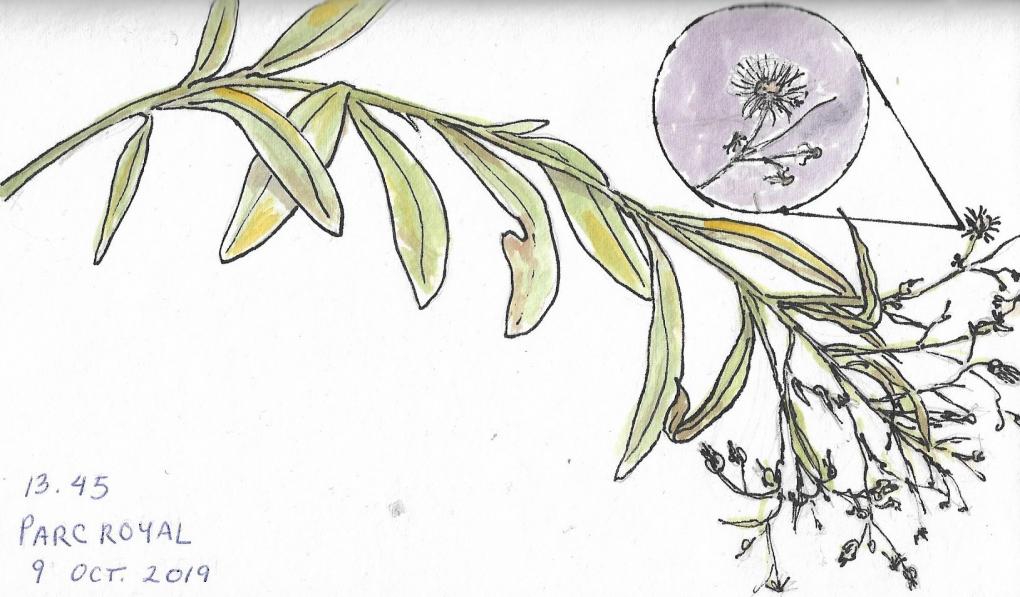
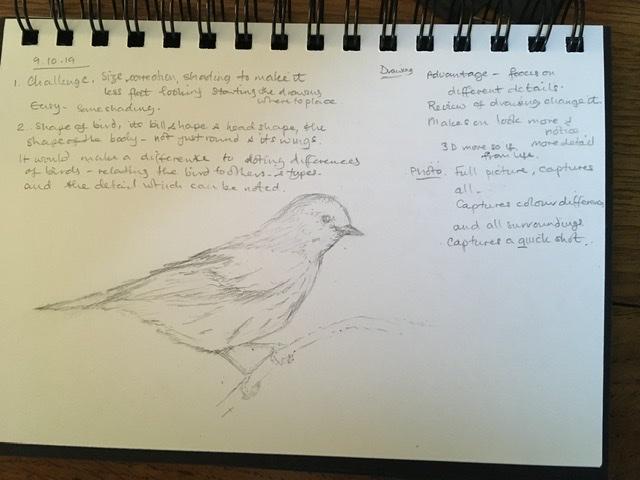
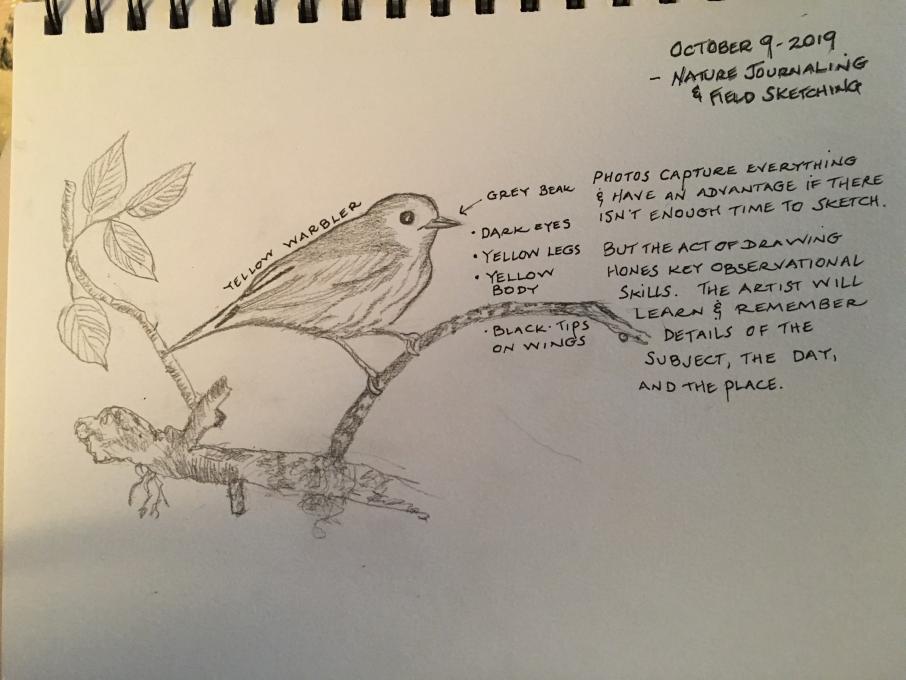
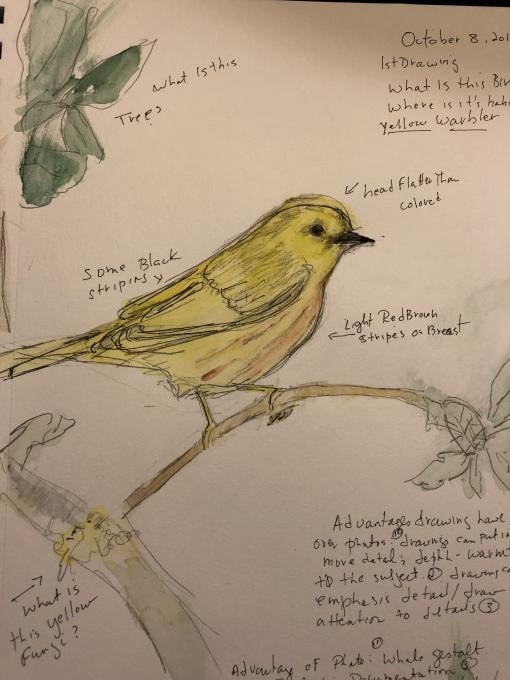
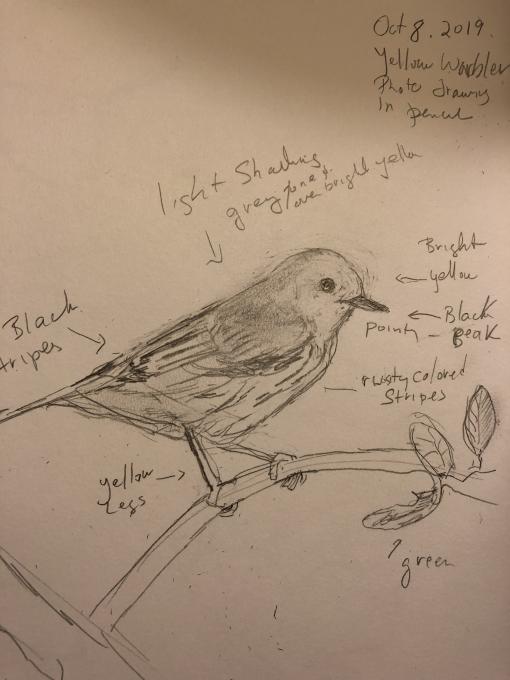 I was very excited to try the new watercolors and watercolor brush suggested in this course. So first I did a color drawing then the pencil drawing. I overworked each drawing.I struggle to get the right angles and proportions. When drawing from a photo I have so much time to think and I don't concentrate on the essence and gesture in the moment but details. My drawing ability , lack of knowledge of bird anatomy and desire to make a realistic drawing stop me from looking at the overall shape and angle of the bird. I'm like a kid in the candy shop caught by all the colored candy (details) not knowing which to choose. I still had fun trying!
I was very excited to try the new watercolors and watercolor brush suggested in this course. So first I did a color drawing then the pencil drawing. I overworked each drawing.I struggle to get the right angles and proportions. When drawing from a photo I have so much time to think and I don't concentrate on the essence and gesture in the moment but details. My drawing ability , lack of knowledge of bird anatomy and desire to make a realistic drawing stop me from looking at the overall shape and angle of the bird. I'm like a kid in the candy shop caught by all the colored candy (details) not knowing which to choose. I still had fun trying! 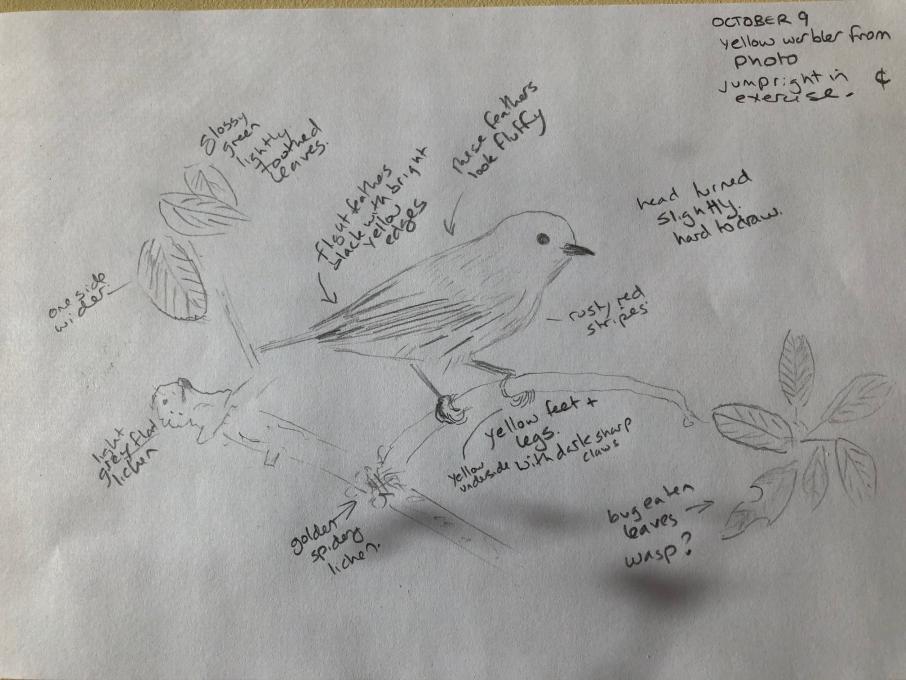 Drawing from a photo I found I could get bogged down in detail so I tried to sketch quickly and take notes of what I noticed. If I had not drawn the picture I may not have noticed the different textures of feathers, the bright yellow undersides of the feet, and the bug nibbled leaf.
Drawing from a photo I found I could get bogged down in detail so I tried to sketch quickly and take notes of what I noticed. If I had not drawn the picture I may not have noticed the different textures of feathers, the bright yellow undersides of the feet, and the bug nibbled leaf. 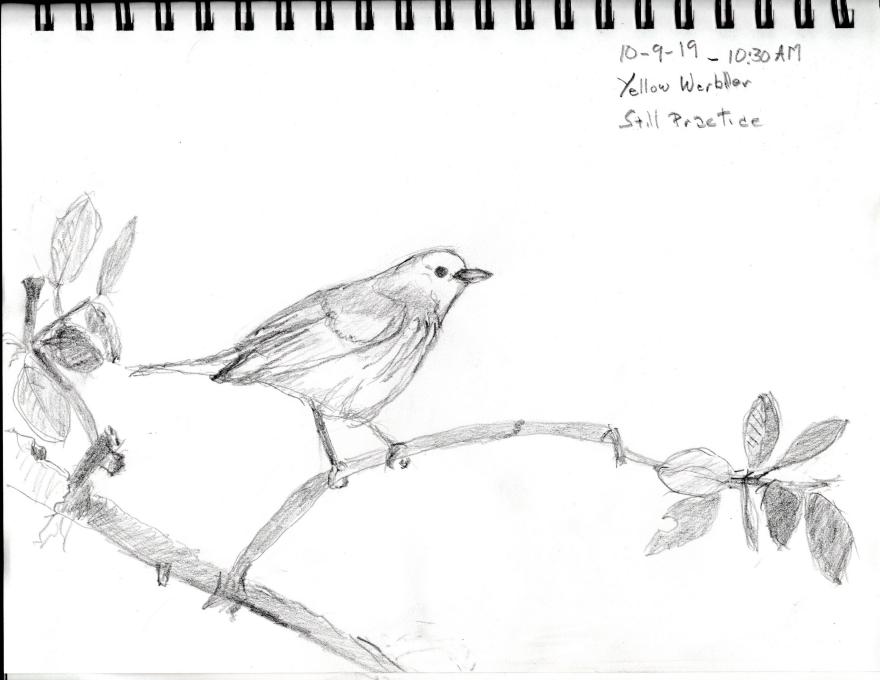 After years of doing technical drawings using a computer, it was nice to use a pencil and paper to draw. (Although I need practice) The longer I took the more details I seemed to have missed.
After years of doing technical drawings using a computer, it was nice to use a pencil and paper to draw. (Although I need practice) The longer I took the more details I seemed to have missed. 
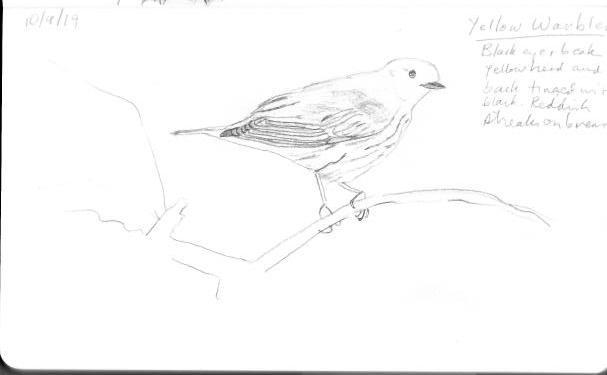
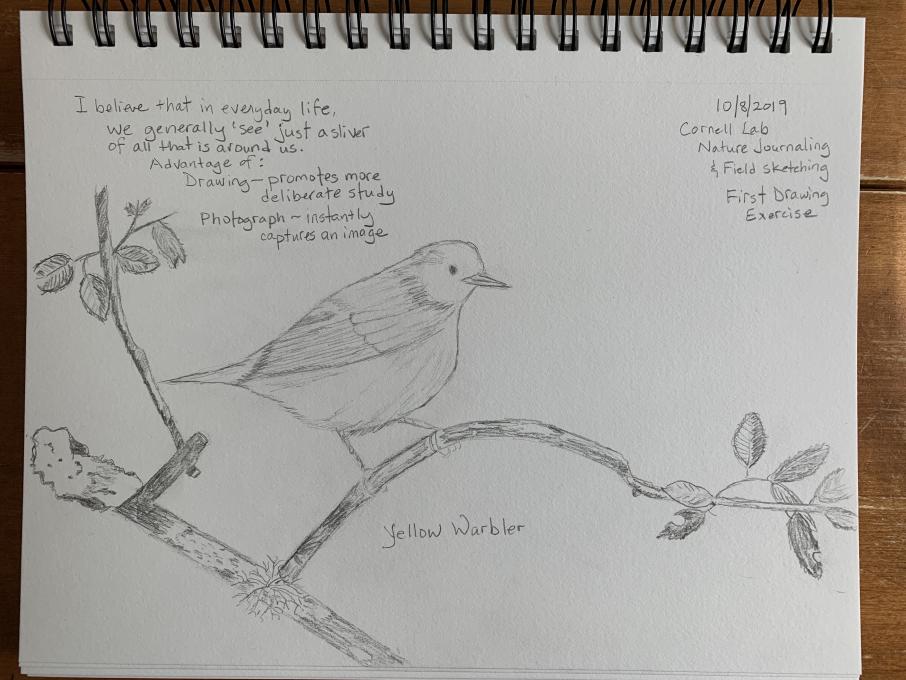
 From photo, I could see different textures of feathers, and also get general geometric shape of subject fairly quickly. This is a technique issue, but it was hard to get fine details of shading rendered with watercolors. I'd use colored pencils in the future. Photo allowed me to get shape of eyes, legs, and beak fairly accurately, which might be difficult from live observation.
From photo, I could see different textures of feathers, and also get general geometric shape of subject fairly quickly. This is a technique issue, but it was hard to get fine details of shading rendered with watercolors. I'd use colored pencils in the future. Photo allowed me to get shape of eyes, legs, and beak fairly accurately, which might be difficult from live observation. 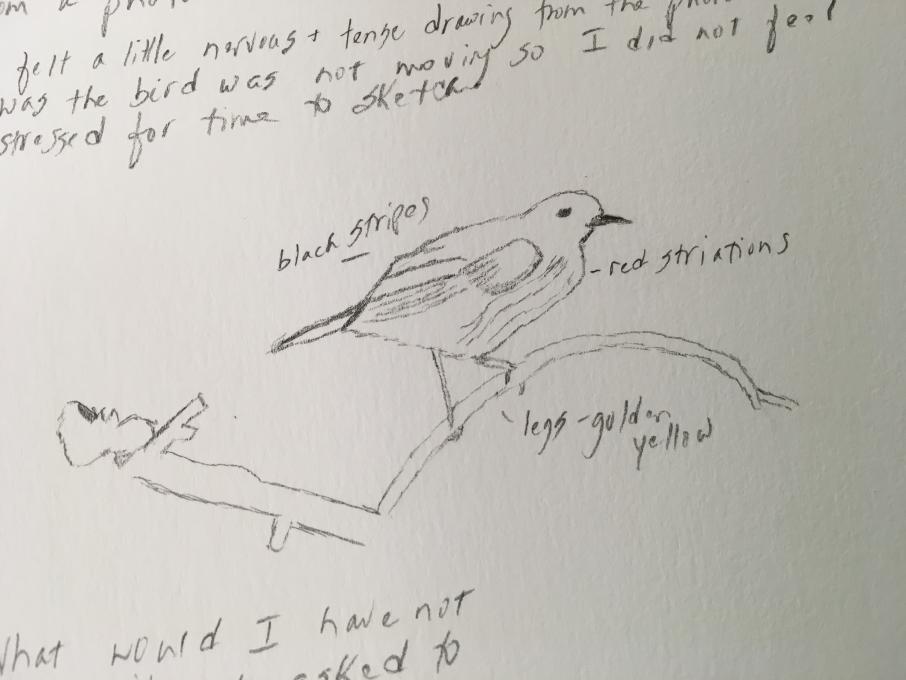
 1. The image was stationary in the photo and therefore I could take my time and observe the whole scene properly. I could only describe the colour in the drawing which was captured realistically in the photo.
2. I would not have noticed the lichen and moss on the branches and the reddish/brown streaks on the bird's chest. The extra bird detail could help with the final identification.
1. The image was stationary in the photo and therefore I could take my time and observe the whole scene properly. I could only describe the colour in the drawing which was captured realistically in the photo.
2. I would not have noticed the lichen and moss on the branches and the reddish/brown streaks on the bird's chest. The extra bird detail could help with the final identification. 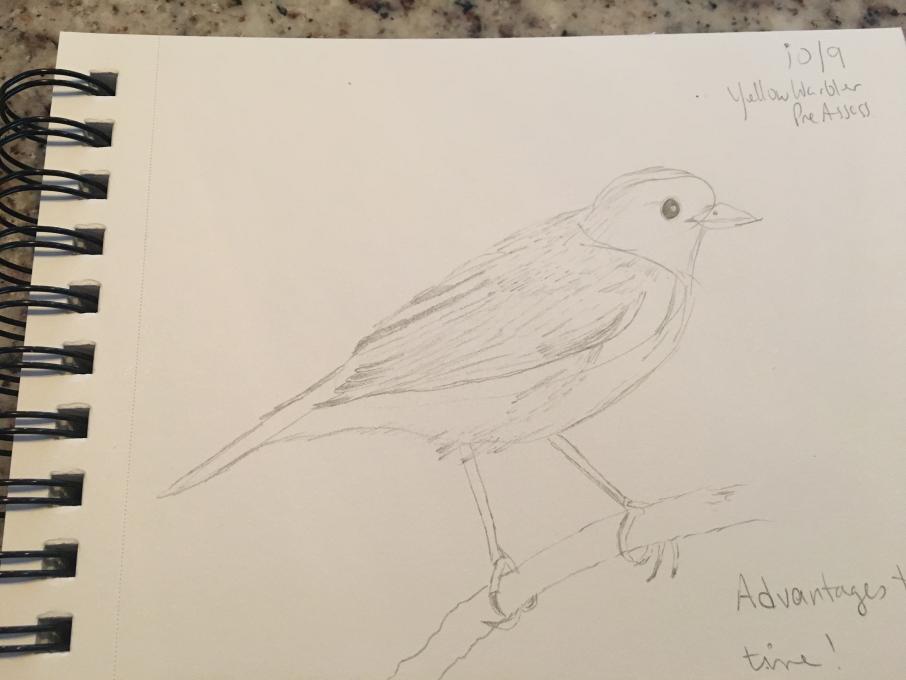
 Drawing from the photo was easy-peasy - that little guy isn't going anywhere, so I can take my time! Challenging? How to know where to stop adding detail? I could sit all day and detail the primary and secondary wing feathers, the shading of his/her neck and delicate legs and nails...
Might not have noticed the shape of the warbler's beak, sort of an "underbite", where the lower part of the beak is larger than the upper part... wouldn't have noticed how the little claws worked as they clamped around the twig... and how the feathers are tight around the head and softer and "fluffier" near the back and vent..
There's drawing from seeing and drawing from "knowing", and the first is probably going to give me the lifelike, dynamic, captured-in-motion look that I'm after, even if I think I'm seeing it wrong... the restatements help make it look like stop-action photography...
Drawing from the photo was easy-peasy - that little guy isn't going anywhere, so I can take my time! Challenging? How to know where to stop adding detail? I could sit all day and detail the primary and secondary wing feathers, the shading of his/her neck and delicate legs and nails...
Might not have noticed the shape of the warbler's beak, sort of an "underbite", where the lower part of the beak is larger than the upper part... wouldn't have noticed how the little claws worked as they clamped around the twig... and how the feathers are tight around the head and softer and "fluffier" near the back and vent..
There's drawing from seeing and drawing from "knowing", and the first is probably going to give me the lifelike, dynamic, captured-in-motion look that I'm after, even if I think I'm seeing it wrong... the restatements help make it look like stop-action photography...
